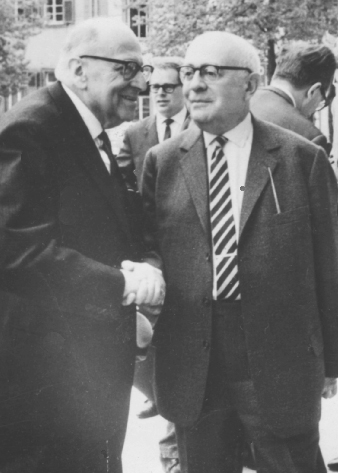Summary:
Adorno and Horkheimer's classic critique of capitalism's cultural impact on art. They believe that movies and media production companies no longer pretend to be creating art, but they are merely businesses producing rubbish (p. 34). They believed that the capitalistic nature of show business absorbed talented individuals before they can create true art and turn them into professionals working for profit. Culture becomes mass-produced, archetypal, and one dimensional in their view. Less variety, difference and choices--they believed-- would be available over time due to this unless there were a proletariat style cultural rebellion.
They further postulated that real life would begin to become indistinguishable from the fabricated life on the screen, and individuals would become like rats to the pied piper of Hollywood. Adorno & Horkheimer believed that when an industry controlled what language, morals, stories, stereotypes and such, they could control the minds and culture of a society. Individuals cease to exist instead, they become social conformists, surviving only if they fit in.
Additional information about the Frankfurt school: from Dayley, C. & Hoffman, D. (2014). The Work of Education in the Age of Digital Reproduction: Frankfurt School and Marxist Critiques of Online Education. IEEE publication in process.
On a precise level, “The Frankfurt School” refers to a group of theorists associated with the Institute of Social Research formed at the University of Frankfurt in 1923. These individuals collectively employed Marxist thought in their use of critical theory and dialectical methods (Held, 1980, p. 14; Frankfurt School, n.d. ). They saw weaknesses in capitalistic systems as well as in Soviet socialism, and sought to answer such concerns with their own interpretation of Marxism.
Amid political turmoil and the rise of Nazi power at the beginning of the Third Reich, these scholars fled Germany and eventually traveled across the Atlantic. For all practical purposes, the Frankfurt School resided at Columbia University, though scholars migrated to major universities across the United States including Columbia, Princeton, Brandeis, and the University of California at Berkeley (Held, 1980, p. 38; Frankfurt School, n.d.; ).
By the end of World War II, most of the members of the Frankfurt School were naturalized American citizens. They noticed similarities between the fascist regimes of Europe and the capitalistic corporate commodity-based culture in North America. They then turned their critical lens on their new homeland and a new English-speaking audience.
It is helpful to note that the term “Frankfurt School” remains somewhat ambiguous in scholastic writing. The term includes individuals who ascribe to the ideas, or who view themselves as philosophical disciples of the founders. In this paper, we apply the term quite broadly, incorporating various philosophical branches of Marxism that stemmed from the school. These groups provide a critical lens whereby weaknesses in distance education may be scrutinized.
Theodore Adorno also rejected the traditional view of Marxism. As a political non-conformist he faced issues in Germany similar to what Horkheimer faced as a German Jew and member of the Frankfurt School (Theodore Adorno, n.d.). He took issues of alienation and reification from early Marxist philosophy, and developed those ideas as critical theory applied to diverse cultural genres. Adorno's Aesthetic Theory –published posthumously—was concerned not only with aesthetic as the function of beauty in art, but with the relations between art and society. He felt that modern art's freedom from such restrictions as cult and imperial functions that plagued previous eras of art led to art's expanded critical capacity and increased formal autonomy (Theodore Adorno, n.d.).
Citation-worthy:
"All amusement suffers from this incurable malady. Pleasure hardens into boredom because, if it is to remain pleasure, it must not demand any effort and therefore moves rigorously in the worn grooves of association. No independent thinking must be expected from the audience: the product prescribes every reaction: not by its natural structure (which collapse under reflection) but by signals" (Adorno & Horkheimer, 1944, p. 35).
"Criticism and respect disappear in the culture industry; the former becomes a mechanical expertise, the latter is succeeded by a shallow cult of leading personalities. Consumers now find nothing expensive. Nevertheless, they suspect that the less anything costs, the less it is being given them… When thrown in free, the now debased works of art, together with the rubbish to which the medium assimilates them, are secretly rejected by the fortunate recipients" (Adorno & Horkheimer, 1944 p. 137).
By the 1940’s, Adorno and Horkheimer (1997) believed that “Movies and radio need no longer pretend to be art. … They are just businesses made into an ideology in order to justify the rubbish they deliberately produce” (p. 121).
"No scope is left for the imagination. Those who are so absorbed by the world of the movie—by its images, gestures, and words—that they are unable to supply what really makes it a world, do not have to dwell on particular points of its mechanics during a screening" (Adorno & Horkheimer, 1944).
“This is the result –not of a law of movement in technology but –of its function in today’s economy” (Adorno & Horkheimer, 1944).
Adorno and Horkheimer critiqued America, “whose monuments are a mass of gloomy houses and business premises in grimy, spiritless cities” (1997, 120).
Adorno & Horkheimer (1944) saw this in fascist Germany and the culture industries, that “perpetually cheat[ed] its consumers of what it perpetually promises.”
Adorno & Horkheimer (1944) stated, Real life is becoming indistinguishable from the movies. The sound film, far surpassing the theatre of illusion, leaves no room for imagination or reflection on the part of the audience, who is unable to respond within the structure of the film (34).
